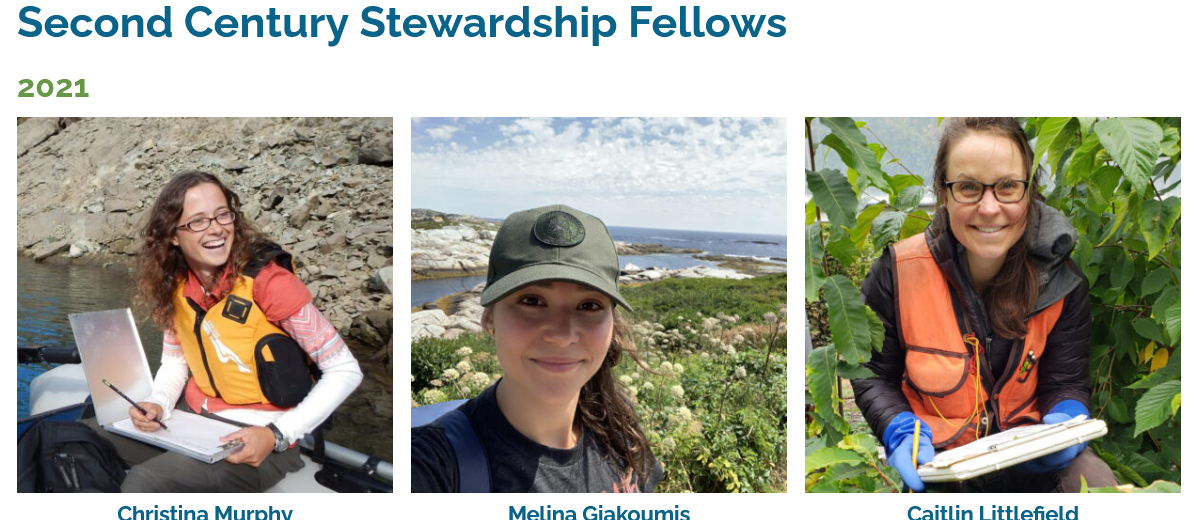Three scientists have been awarded fellowships to conduct research in Acadia National Park as part of Second Century Stewardship, an initiative of the National Park Service, Schoodic Institute at Acadia National Park and the National Park Foundation.
The new awards will support research that will inform management of land, water, wildlife and cultural resources in Acadia, as well as supporting public engagement with park science.
The 2021 Second Century Stewardship Fellows are:
- Melina Giakoumis, Ph.D. candidate at City University of New York;
- Caitlin Littlefield, Research Assistant Professor in the Rubenstein School of Environment and Natural Resources at the University of Vermont;
- Christina Murphy, Assistant Unit Leader of the USGS Maine Cooperative Fish and Wildlife Research Unit at the University of Maine.
Like many national parks, Acadia is experiencing rapid changes including warming temperatures, shifts in plant and animal populations, rising sea levels and altered weather patterns. These changes are not fully understood, challenging the National Park Service to manage and protect both natural and cultural resources.
“We need new science to help us better understand these complex changes and how we can effectively respond, so that future generations can enjoy and be inspired by Acadia and other national parks. These fellows will help us do that,” said Kevin Schneider, Superintendent of Acadia National Park.
“We’re really excited for our new fellows, they will be leading critical research here in Acadia and communicating their work to increase public understanding and support for science in parks and science for the planet,” said Nicholas Fisichelli, Schoodic Institute President and CEO.
The new awards, made possible in part by a grant from the National Park Foundation through a generous donation from the David Evans Shaw Family Foundation, increase to 15 the total number of Second Century Stewardship fellowships awarded since 2016, when Second Century Stewardship launched upon the centennial of the National Park Service to provide relevant scientific research for park stewardship, increase public engagement with science and pursue solutions to critical issues for parks and society.
“These research fellowships apply science to address the many management issues facing our national parks. Congratulations to the fellows, and to Schoodic Institute and Acadia National Park for their leadership in a program with such compelling and far reaching implications for smart, science-based stewardship of our natural world,” said David Shaw, founder of Second Century Stewardship.
More about the fellows and their research:
Melina Giakoumis intends to study Asterias sea stars, an important animal in coastal food webs that may show how life in the intertidal zone is changing in response to warming temperatures, changing ocean chemistry and rising sea levels. Giakoumis will use several methods, including revisiting a 1979 study on sea star abundance in Acadia, Boston Harbor Islands National Recreation Area and Cape Cod National Seashore, to understand population changes over time and track outbreaks of Sea Star Wasting Disease.
“Because of their role as keystone predators, sea stars’ ability to adapt will impact many other species,” said Abe Miller-Rushing, Science Coordinator for Acadia National Park. “In addition, Giakoumis will create a model for studying how other critical species are responding to climate change by incorporating historical records, current population assessments, observations of disease spread, genetics and other techniques.”
Caitlin Littlefield’s research focuses on the unique interface where coastal spruce-fir forests meet salt marshes. Managers of coastal lands generally want to enable salt marshes to migrate inland as sea levels rise, because marshes filter water and provide important habitat, among many other functions. In some areas, salt marshes may encroach on coastal spruce-fir forests, which are also vulnerable to rising temperatures and are at the southern edge of their range in Acadia.
According to Acadia National Park plant ecologist Jesse Wheeler, there is a wide range of important work taking place in salt marshes in and around the park that could be informed by Littlefield’s research. “For example, it will help us plan vegetation restoration at the upland edge of Bass Harbor Marsh, and may inform our work with Wabanaki scientists and harvesters to preserve sweetgrass populations, which grow near upland edges of salt marshes and are culturally significant,” said Wheeler.
Christina Murphy is evaluating the impact of invasive fishes in lakes of Acadia National Park. Building on an extensive archive of data, Murphy will focus on the role of non-native fish in aquatic food webs, and how they may influence exposure of other wildlife to mercury and similar contaminants in park ecosystems.
“We know so little about the impacts of non-native invasive fish on Acadia’s lakes and wildlife,” said Acadia National Park wildlife biologist Bik Wheeler. “This study will help us understand just how far-reaching the impacts could be.”
The Second Century Stewardship approach to research, science communication and citizen science has been integrated with the efforts of more than 50 units and programs of the National Park System.
###




